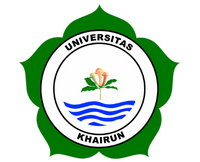Watermelon Production in Dry Land with Liquid Biofertilizer and Different Compound NPK
Abstract
An area of 12.90 million ha of dry land has not been used optimally for agriculture, opportunity available to plant watermelons with proper cultivation techniques, including the use of biological and inorganic fertilizers. Biofertilizers can help provide NPK nutrients for watermelon plants. The purpose of this study was to determine the appropriate dosage of biological fertilizers and compound NPK for increasing watermelon yields. The research was conducted at AKN Sakojo No.21 Kel. Kedondong Raya Kec. Banyuasin III Pangkalan Banyuasin City Hall, South Sumatra from July to October 2020. This study used a factorial randomized block design (RAK). Factorial 1 is the dose of liquid biological fertilizer, namely: 10 mL/L, 20 mL/L, and 30 mL/L. Factorial II is Compound NPK, namely: 600 kg/ha, 900 kg/ha, and 1200 kg/ha. The highest production of 22.32 kg/plot (38 tons/ha) was achieved at a dose of 30 mL/L of liquid biological fertilizer and 1200 kg/ha of compound NPK fertilizer.
Keywords
Full Text:
PDFReferences
Al-Khafaji MH 2018. Effect of rhizobia and mycorrhiza inoculants and concentrations of vitamin B-complex on the growth and yield of (Vicia faba L.). Ph.D. Thesis, College of Agriculture, Al-Muthanna University
Al-Samawi HNK 2012. Field Evaluation of some plants water extracts on nitrification inhabitation, ammonia volatilization and barley growth (Hordeum vulgare L.). Ph.D. Thesis, College of Agriculture, Baghdad University.
Badan Pusat Statistik. 2017. Produksi Hortikulra. Badan Pusat Statistik
Bekele M 2018. Effects of different levels of potassium fertilization on yield, quality and storage life of onion (Allium cepa L.) at Jimma, Southwestern Ethiopia. Journal of Food Science and Nutrition 1(2): 32-39.
Fagi, A.M. dan I. Las. 2006. Konsepsi pengendalian pencemaran lingkungan secara terpadu berbasis DAS. Makalah disampaikan dalam Seminar Nasional Pengendalian Pencemaran Lingkungan Pertanian melalui Pendekatan Pengelolaan DAS Secara Terpadu. Kerjasama Lolingtan-UNS-HITI, Surakarta 28 Maret2006. Hlm 14.
Kaviani B and Negahd N 2016. Effects of biological nanofertilizer on the morphological, physiological and proliferation traits and quality of Buxus Hyrcana Pojark. Bangladesh Journal of Botany 45(5): 1135-1142.
Mandal MSH, Ali MH, Amin AKMR, Masum SM and Mehraj H 2015. Influence of source of nitrogen on growth and yield of wheat. International Journal of Agronomy and Agricultural Research 6(1): 89-95.
Mirzaei A, Vazan S and Naseri R 2010. Response of yield components of safflower (Carthamus tinctorius L.) to seed inoculation with Azotobacter and Azosprilium and different nitrogen levels under dry land condition. World Applied Science Journal 11(10): 1287-1291.
Malhotra H, Vandan, S Sharma & R Pandey. 2018. Phosphorus Nutrition: Plant Growth in Response to Deficiency and Excess. N book: Plant Nutrient and Abiotic Stress Tolerance (pp 171-190)
Marlina, N., & Gusmiatun. 2020. Ragam Pupuk Hayati untuk Meningkatkan Produktivitas Kedelai di Lahan Lebak. Jurnal Agrosaintek. 4(2).129-136
Prajapati K and HA Moda. 2012. The Importance of Potassium in Plant Growth. A Review. Indian Journal of Plant Secience 1(02=03):177-186
Valizadeh M and Milic V 2016. The effects of balanced nutrient managements and nano-fertilizers effects on crop production in semi-arid areas. Current Opinion in Agriculture 5(1): 31-38.
Shende S, Rathod D, Gade A and Rai M 2017. Biogenic copper nanoparticles promote the growth of pigeon pea (Cajanus cajan L.). IET Nanobiotechnology 11(7): 773-781.
Steenhoudt O & J Vanderleyden. 2000. Azospirillum, a free-living-nitrogen-mixing bacterium closely associated with grasses: genetic, biochemical, and ecological aspects. FEMS Microbiology Reviews 487-506
Suryatmana P, MR Setyawati, DN Fitriatin, D Herdiyantoro & R Hindersah. 2016. The Application of Biofertilizer Consortium to Enhance Quality and yield of Vegetables (Lactuca sativa L.) Crop and to Reduce Chemical Fertilizer Usage. Academic Journal of Science 06(01):353-364 (2016)
Syafrullah & N. Marlina. 2015. Nutrisi Tanaman Alami. Palembang: Tunas Gemilang Press.
Wang, Z. H., S. Xli and S. Malhi, 2008. Effects of fertilization and other agronomic measures on nutritional quality of crops. Journal of the Science of Food and Agriculture,88(1): 7-23.
DOI: https://doi.org/10.32502/jgsa.v2i1.3817
Refbacks
- There are currently no refbacks.
Indexed by:
Journal of Global Sustainable Agriculture
Diterbitkan oleh Fakultas Pertanian, Universitas Muhammadiyah Palembang
Contact Person:
Rika Puspita Sari, M.Si (+62 813-7490-0341)
Klinik Publikasi Pertanian
Faculty of Agriculture, Universitas Muhamamdiyah Palembang
JL. Jend. A. Yani 13 Ulu Palembang, South Sumatra, Indonesia
Tel. (+62)711-511731; Email: kppfpump@gmail.com; Website: https://jurnal.um-palembang.ac.id/JGSA

This work is licensed under a Creative Commons Attribution 4.0 International License.







1.png)

13.png)





